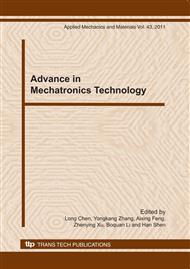[1]
A. Dunkels, B. Gr¨onvall, and T. Voigt: Contiki – a lightweight and flexible operating system for tiny networked sensors. In Proceedings of the First IEEE Workshop on Embedded Networked Sensors (IEEE Emnets '04), Tampa, Florida, USA, November (2004).
DOI: 10.1109/lcn.2004.38
Google Scholar
[2]
J. Schiller, H. Ritter, A. Liers, and T. Voigt: Scatterweb - low power nodes and energy aware routing. In Proceedings of Hawaii International Conference on System Sciences, Hawaii, USA, January (2005).
DOI: 10.1109/hicss.2005.529
Google Scholar
[3]
O. Landsiedel, K. Wehrle, and S. G¨otz: Accurate prediction of power consumption in sensor networks. In Proceedings of The Second IEEE Workshop on Embedded Networked Sensors (EmNetS-II), Sydney, Australia, May (2005).
DOI: 10.1109/emnets.2005.1469097
Google Scholar
[4]
C. Park, K. Lahiri, and A. Raghunathan: Battery discharge characteristics of wireless sensor nodes: An experimental analysis. In Proceedings of the IEEE Conf. on Sensor and Ad-hoc Communications and Networks (SECON), Santa Clara, California, USA, September (2005).
DOI: 10.1109/sahcn.2005.1557096
Google Scholar
[5]
J. Polastre, R. Szewczyk, and D. Culler. Telos: Enabling ultra-low power wireless research: In Proc. IPSN/SPOTS'05, Los Angeles, CA, USA, and April (2005).
DOI: 10.1109/ipsn.2005.1440950
Google Scholar
[6]
H. Ritter, J. Schiller, T. Voigt, A. Dunkels, and J. Alonso: Experimental Evaluation of Lifetime Bounds for Wireless Sensor Networks. In Proceedings of the Second European Workshop on Sensor Networks(EWSN2005), Istanbul, Turkey, January (2005).
DOI: 10.1109/ewsn.2005.1461996
Google Scholar
[7]
T. Staub, T. Bernoulli, M. Anwander, M. Waelchli, and T. Braun. Experimental lifetime evaluation for mac protocols on real sensor hardware. In Proceedings of ACM Workshop on Real-World Wireless Sensor Networks (REALWSN'06), Uppsala, Sweden, June (2006).
Google Scholar
[8]
M. Buettner, G. V. Yee, E. Anderson, and R. Han. X-mac: a short preamble mac protocol for duty-cycled wireless sensor networks. In SenSys '06: Proceedings of the 4th international conference on Embedded networked sensor systems, pages 307–320, Boulder, Colorado, USA, (2006).
DOI: 10.1145/1182807.1182838
Google Scholar
[9]
O. Younis and S. Fahmy: An experimental study of routing and data aggregation in sensor networks. In Proceedings of the IEEE International Workshop on Localized Communication and Topology Protocols for Ad Hoc Networks (IEEE LOCAN), Washington, DC, USA, November (2005).
DOI: 10.1109/mahss.2005.1542773
Google Scholar
[10]
X. Jiang, P. Dutta, D. Culler, and I. Stoica: Micro power meter for energy monitoring of wireless sensor networks at scale. In IPSN '07: Proceedings of the 6th international conference on Information processing in sensor networks, pages 186–195, Cambridge, Massachusetts, USA, (2007).
DOI: 10.1145/1236360.1236386
Google Scholar


